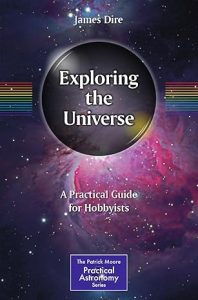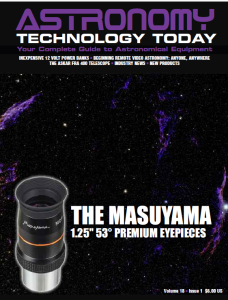Exploring the Universe: A Practical Guide for Hobbyists by Dr. James Dire is an insightful resource tailored for both novice and seasoned amateur astronomers. Part of the highly popular The Patrick Moore Practical Astronomy Series, the book offers a comprehensive journey through the cosmos, emphasizing what can be achieved with modest and affordable equipment.
 One of the unique aspects of the book is that Dr. Dire dedicates a significant portion to solar astronomy, providing readers with practical guidance on observing and understanding our Sun. He offers detailed instructions on safely observing solar phenomena, emphasizing the importance of proper equipment and techniques to protect both the observer and their instruments.
One of the unique aspects of the book is that Dr. Dire dedicates a significant portion to solar astronomy, providing readers with practical guidance on observing and understanding our Sun. He offers detailed instructions on safely observing solar phenomena, emphasizing the importance of proper equipment and techniques to protect both the observer and their instruments.
Exploring the Universe: A Practical Guide for Hobbyists includes a variety of solar images captured by the author using modest telescopes, demonstrating that high-quality solar observation is accessible to amateur astronomers. These images serve as both inspiration and practical examples, illustrating the dynamic features of the Sun that can be observed with affordable equipment. Dr. Dire’s accessible writing style ensures that readers at all levels can grasp the complexities of solar observation, making this section a valuable resource for those looking to explore solar astronomy.
The guide begins with an in-depth primer on the various types of telescopes available in today’s market, discussing the advantages and disadvantages to help readers make informed decisions. Following this, Dire introduces readers to the fundamentals of astrophotography, providing practical advice on capturing celestial images. He also offers a thorough description of both paper and digital star atlases, aiding enthusiasts in navigating the night sky. A discussion on celestial nomenclature explains the naming conventions of astronomical objects, enhancing the reader’s understanding of the universe’s vast catalog.
One of the standout features of this book is its extensive collection of astronomical images, all captured by the author himself using smaller telescopes. These images serve as a testament to what can be accomplished without access to large observatories or space telescopes like Hubble or James Webb. The visual content not only inspires but also educates readers on the physical processes and characteristics of various celestial objects.
The latter sections of the book take readers on a grand tour of the universe, covering a wide array of topics from the Moon and Sun to comets, nebulae, star clusters, and galaxies. Throughout, Dire’s descriptions are accessible, making complex astronomical concepts understandable for readers at any level. His dual experience as a career astronomy professor and an avid amateur astronomer enriches the content, bridging the gap between professional insights and practical, hands-on advice.
 Dr. James Dire is an acclaimed astronomy writer, having bridged the gap between professional and amateur astronomy for many decades and is a leading expert on amateur telescopes and related equipment.
Dr. James Dire is an acclaimed astronomy writer, having bridged the gap between professional and amateur astronomy for many decades and is a leading expert on amateur telescopes and related equipment.
He earned bachelor’s degrees in chemistry, physics and mathematics from the University of Missouri-Kansas City followed by a master’s degree in physics from the University of Central Florida. He earned his PhD from The Johns Hopkins University. His dissertation was a study of the seasonal organic chemistry in the atmosphere of Saturn’s large moon Titan.
While at UMKC, Dire joined the Astronomical Society of Kansas City where he served as president his senior year in college. Over his career he continued to work with many amateur organizations including the Central Florida Astronomical Society (Orlando), the Baltimore Astronomical Society, the Astronomical Society of New Haven, the Thames Amateur Astronomical Society (New London, CT), the Cleveland County (NC) Astronomical Society, the Las Vegas Astronomical Society, the Peoria Astronomical Society, and the Kauai Educational Association for Science and Astronomy. He is still very active with the latter three.
Dr. Dire began doing astronomical imaging while an undergraduate, back then using film. He advanced to digital sensors using them both for research and producing splendid images. He has been a top contributor for Astronomy Technology Today since 2008 reviewing emerging astronomical equipment, books and software.
Since 2009, Dr. Dire has authored a Deep-Sky column in every issue of the Reflector. Scores of his astronomical images have appeared in these publications as well as Sky and Telescope and many newspapers.
Dr. Dire also is one of the world’s leading authorities in viewing and imaging solar phenomena. With his scholarly work, field observations, and equipment evaluations, Dr. Dire has significantly advanced the practice and appreciation of solar astronomy among both amateur and professional communities.
Throughout his extensive career, he has actively contributed to the field of solar astronomy through various roles and publications. Notably, Dr. Dire serves as an editorial consultant for Solar Astronomy Today, which is dedicated to advancements and insights in solar observation and imaging.
His passion for solar eclipses has led him to travel across five continents, including countries such as China, Iceland, Turkey, and Zambia, as well as tropical islands like Aruba and Hawaii, to witness and document these celestial events. This extensive experience has provided him with valuable insights into the planning and execution of solar observation expeditions.
In his writings, Dr. Dire has explored various aspects of solar observation. For instance, in a 2017 article for Astronomy Technology Today, he detailed his preparations for observing a solar eclipse in his hometown of Saint Joseph, Missouri, highlighting the equipment and strategies employed to capture the event.
Dr. Dire’s contributions to solar astronomy are further exemplified by his reviews of solar observation equipment. In a 2023 issue of Astronomy Technology Today, he provided an in-depth analysis of the Celestron EclipSmart line of solar instruments, assessing their performance and value for enthusiasts.
Dr. Dire has been a chemistry, physics and astronomy professor for most of his professional career. However, he has spent a majority of the past two decades as a college administrator at every level from a department chair to a president.
You can learn more about Exploring the Universe: A Practical Guide for Hobbyists here.

 And if you want to learn more about safely viewing and imagng the Sun, The Definitive Equipment Guide to Viewing and Imaging the Sun ca be found here. It provides an easy-to-consume introduction to the technological options for enhancing your solar imaging and observing experience. We cover the gamut of options available including building your own solar viewer, solar glasses, smart phones, DSLR cameras, astronomy telescopes, solar telescopes, binoculars, solar filters (including a DYI filter option), CCD astro cameras, astro video cameras, and much more.
And if you want to learn more about safely viewing and imagng the Sun, The Definitive Equipment Guide to Viewing and Imaging the Sun ca be found here. It provides an easy-to-consume introduction to the technological options for enhancing your solar imaging and observing experience. We cover the gamut of options available including building your own solar viewer, solar glasses, smart phones, DSLR cameras, astronomy telescopes, solar telescopes, binoculars, solar filters (including a DYI filter option), CCD astro cameras, astro video cameras, and much more.
And to make it easier for you to get the most extensive news, articles and reviews that are only available in the magazine pages of Astronomy Technology Today, we are offering a 1-year magazine subscription for only $6! Or, for an even better deal, we are offering 2 years for only $9. Click here to get these deals which only will be available for a very limited time. You can also check out a free sample issue here.

